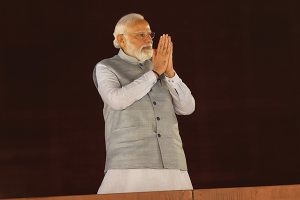Bloomberg
For all the success of the US-led campaign to isolate Russia on the world stage, India has stood out as one major democracy that has been reluctant to criticise Vladimir Putin — and billions of dollars in weapons purchases mean that’s unlikely to change anytime soon.
Prime Minister Narendra Modi’s government is facing more pressure from fellow members of the Quad — the US, Japan and Australia — to help push Russia towards a ceasefire. After meeting Modi in New Delhi, Japanese Prime Minister Fumio Kishida called for more cooperation between democracies while noting Putin’s war has “shaken the global order.†Modi, by contrast, only spoke on economic issues.
Modi is slated to hold a virtual summit on Monday with Australian Prime Minister Scott Morrison, while US Undersecretary for Political Affairs Victoria Nuland — who has helped coordinate the American response to Ukraine — is expected to visit New Delhi later this week.
India, the world’s largest buyer of Russian weapons, plans to push back by arguing the purchases are necessary to counter China’s growing military assertiveness and its other neighbour, Pakistan. Modi’s government will also say the alternatives to Russian weapons are too expensive, according to people familiar with the situation, who asked not to be identified because they are not authorised to speak with the media.
India operates over 250 Su-30 MKi Russian-made fighter jets, seven Kilo-class submarines and more than 1,200 Russian-made T-90 tanks — all of which are operational for another decade, the people said. In the pipeline are weapon systems worth about $10 billion that include a nuclear submarine to be leased to India and
S-400 air defense system batteries. India’s Ministry of Defense didn’t immediately reply to a request for comment outside of regular business hours.
“Despite efforts at diversification, India’s military hardware is still almost 70% Russian,†said Manjari Chatterjee Miller, a senior fellow for India, Pakistan and South Asia at the Council on Foreign Relations and author of “Why Nations Rise: Narratives and the path to Great Power.†India “has to continue to rely on Russia for parts, maintenance and upgrades,†she added.
The cost for India to replace all of its Russian-origin equipment is daunting. India’s entire defense budget for 2021-22 is $70 billion, and a long-delayed plan to procure 114 fighter jets to replenish its fleet and replace some older Russian fighters is estimated to cost India between $15 billion and $18 billion even if produced domestically, the people said. “New Delhi also lacks options to replace military systems like air defense platforms it cannot easily get elsewhere,†said Ian Hall, professor of international relations at Griffith University and author of “Modi and the Reinvention of Indian Foreign Policy.â€
 The Gulf Time Newspaper One of the finest business newspapers in the UAE brought to you by our professional writers and editors.
The Gulf Time Newspaper One of the finest business newspapers in the UAE brought to you by our professional writers and editors.
